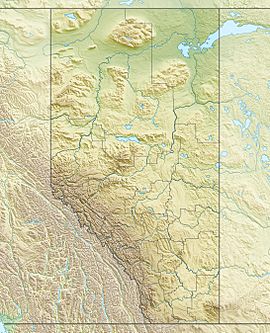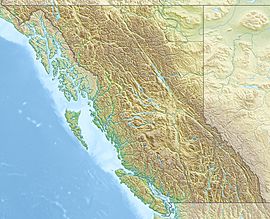Scarab Peak (Canada) facts for kids
Quick facts for kids Scarab Peak |
|
|---|---|

Scarab Peak above Scarab Lake
|
|
| Highest point | |
| Elevation | 2,918 m (9,573 ft) |
| Prominence | 713 m (2,339 ft) |
| Listing | Mountains of Alberta Mountains of British Columbia |
| Geography | |
| Country | Canada |
| Parent range | Ball Range, Canadian Rockies |
| Topo map | NTS 82O/04 |
| Geology | |
| Age of rock | Cambrian |
| Type of rock | Sedimentary rock |
Scarab Peak is a tall mountain in Canada. It stands 2,918 metres (9,573 ft) high! This peak is right on the Continental Divide. This means it sits on the border between two big national parks: Banff and Kootenay. Scarab Peak is part of the Ball Range, which is a group of mountains in the amazing Canadian Rockies.
The mountain is located near Haiduk Peak and Mount Ball. Its name, "Scarab," comes from an ancient Egyptian beetle. This name fits with other places nearby, like Egypt Lake and Pharaoh Peaks. These names were given in 1922 by a surveyor named Arthur O. Wheeler. He thought this area was incredibly beautiful. He even wrote that after exploring the Canadian Rockies for 30 years, the Egypt Lake area was one of the most charming and interesting places he had ever seen!
What Scarab Peak is Made Of
Just like other mountains in Banff Park, Scarab Peak is made of sedimentary rock. This type of rock forms from layers of sand, mud, and tiny bits of plants and animals that settle at the bottom of ancient seas. Over millions of years, these layers get pressed together and turn into rock.
The rocks in Scarab Peak were formed during very old times, from the Precambrian to the Jurassic periods. Later, during a huge event called the Laramide orogeny, these rocks were pushed up and folded. This is how the mighty mountains we see today were created!
Weather at Scarab Peak
Scarab Peak has a subarctic climate. This means it has very cold winters with lots of snow. The summers are usually mild, but still cool. Temperatures can drop below −20 °C (that's really cold!). With the wind blowing, it can feel even colder, sometimes below −30 °C. So, if you ever visit, make sure to bundle up!



